Houseplants With Orange Flowers includes Goldfish Plant, Christmas Cactus, Florist Kalanchoe, Orange Golden Brush, Basket Vine, Eternal Flame, Trailing Jade Plant, Orange Woolly Rose, Hippeastrum, Parrot’s Beak, Kaffir Lily, Lycaste Orchid, Ornamental Pepper Plant, Bird of Paradise, Barberton Daisy.
Adding flowers to your house, especially those orange flowers can make your interior beautiful and attractive.
Most people have flowers that are red, yellow, pink, blue but now adding one or two that are orange will brighten the indoors with a mix of colors.
Most of the indoor orange flowers have low maintenance requirements and can easily bloom when they mature in spring and some flowers in late winters as well.
HOUSE PLANTS WITH ORANGE FLOWERS
Here is the list of indoor house plants with orange flowers:
Christmas Cactus
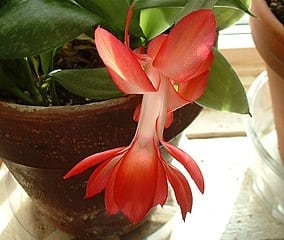
Christmas cactus (Schlumbergera truncata) is one of the plants that produce orange flowers in the growing season. They don’t have leaves and the task of leaves is done from the stem as they do all the food making process called photosynthesis using sunlight.
It is a member of the cactaceae family and they are generally found in tropical to subtropical areas where they are comfortable to grow.
Christmas cactus is one of the winter growing cacti that grows in shade to partial shade. You should also put moderate humidity in the room to make it happy. The cactus don’t need good soil, all they need is soil that has good draining, although it’s a tough plant won’t die that easily. This plant loves moist soil but can adjust to dry soils.
The USDA zone for christmas cactus is 10a and that is why they mostly love warm temperatures. This house plants has a height of 2 to 4 feet and you can easily multiple this cactus to create new plants.
The plants in forest-like areas can climb trees or may grow like a shrub.
Florist Kalanchoe
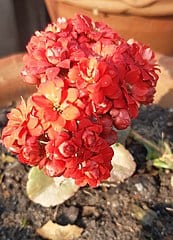
Florist kalanchoe is a beautiful flowering plant with orange flowers. The kalanchoe is an easy to grow and low maintenance plant. The scientific name of this plant is kalanchoe blossfeldiana and it is a perennial succulent plant. These plants are easy to propagate by using the tip of the leaf or you can cut off any of the healthy stems to multiply these plants. This way you can create a whole garden using the stem of the plant through propagation. They like to have moisture around and if it has low water level then the leaves may dry. That is why it is important to water your florist kalanchoe. The plant can grow up to 17 to 18 inches and similarly it can spread to 17 to 18 inches.
The plant can be easily affected by overwatering so I recommend everyone not to water too much and only water when the plant feels dry or the topsoil is 2 inch dry.
They also like to grow in warm temperatures and similar to the above Christmas cactus they do grow in USDA zone 10a. They like full sun to partial shade locations. There are different flowering plants similar to our florist kalanchoe, just like daisies and other flowers.
Basket Vine
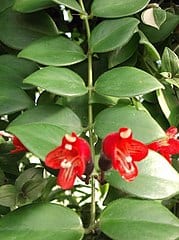
Basket vine as the name suggests is a vine based flowering plant. The scientific name of this plant is Aeschynanthus specious and it has green leaves with orange flowers. The size of the flower is about 2 to 4 inch and it is quite a bushy plant. The basket vine is easy to propagate as you only need a tip of cuttings to make new plants. They live in tropical forests so they only like to grow in partial shade areas and not in full sunlight. Yes they do tolerate humid areas and you should grow them in well draining soil. You normally water the plant and do not overwater to avoid any root rot issue.
They also like to grow in warm temperature areas. similar to above 2 plants basket vine is also hardy to zone 10b. The plant has a height of over 10 to 11 inches and it spreads over 17 to 18 inches. These plants are best suited for garden corners and also in tropical areas it can easily climb to trees.
Eternal Flame
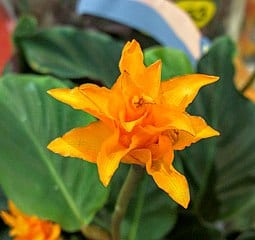
Similar to the other 2 house plants with orange flowers it is an evergreen, low maintainable plant. They require good watering and can grow in partial shade. The method to propagate eternal flame is easy and you can easily use cuttings to make new plants. The plants do dislike overwatering as it can create root rot problem. The plant lives in tropical climatic conditions that prefers filtered to partial light source location to grow. The USDA hardiness for the eternal flame is zone 13 & they like warm temperatures to normally keep up with the growth.
The eternal flame plant has a height of 15 to 18 inches and it can spread up to 10-12 inches. These plants prefer fertile soil to produce orange flowers so make sure to provide fertilizer in its growing season.
Trailing Jade
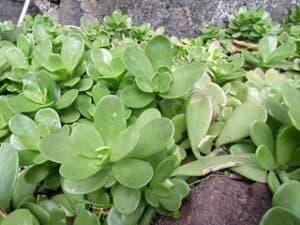
As the name suggests trailing jade is one of the house plants that produces orange flowers. Scientific Name of this plant is Kleinia petraea & they grow in a warm environment. The plant has oval shaped leaves with green color and it trails with the flow mostly downward or using wires to make it travel like a vine based plant.
The plant requires less water so if you overwater it then it may cause root rot. Trailing jade likes full sun but can grow in partial shade. The hardiness zone for the plant is 10a just like the 1st few plants that i described about. The trailing jade can grow up to 5 to 6 inches and it can spread up to 19 inches. You can easily grow it indoors as well as outdoors. Pruning can be done to avoid any disease in this plant. You can easily propagate trailing jade using leaf or stem cuttings. The propagation is simple and easy to follow so that a beginner garter can do the task.
Golden Brush
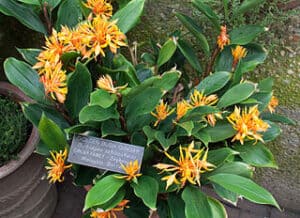
Golden brush is another flowering house plants with orange flowers, they belongs to Borneo. The scientific name of the plant is burbidgea scheizocheila and these blooms are produced for the whole year that is why the caring is required throughout the year. The size of flower are 2 to 3 inches only and the plant can reach to a height of over 23- 24 inches tall. It is a perennial plant that means golden brush will grow for many years after successfully tolerating cold climate conditions.
These plants prefer partial shade and you should give water so that its topsoil becomes moist. Do not give too much water to your golden brush as they can be not tolerate the fungal infection that may cause due to root rot. hardiness zone for the plant is zone 10a and they are easy to grow with low care needs.
Woolly Rose
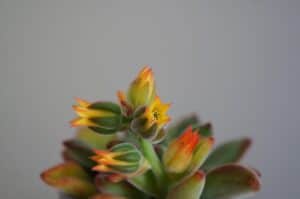
Woolly Rose are one of the unique house plant with orange flowers. The scientific name of this plant is Echeveria Doris Taylor. Woolly roses like to grow in warm environments and they can tolerate moderate humidity. The propagation technique is simple and easy to follow in the woolly rose plant so using a leaf cutting or taking out offsets of the plant can make new plants. These plants are grown in outdoor as well as indoor area with full sunlight. They are evergreen flowering plants with a bloom that are produced from the end of the spring to the start of the summer. It is a succulent based plant with the flower having 1 inch length.
Hippeastrum
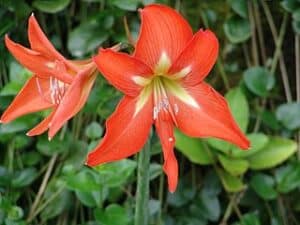
Hippeastrum is a houseplant that comes from Tanzania and Brazil which produces orange flowers. Scientific name of this plant is Hippeastrum striatum which is comfortably grown in the growing season. Hippeastrum likes the warm climate and it is an easy to grow plant which can handle moderate humidity. These plants have long green leaves which require full sun but yes it can grow in filters to partial shade light areas. The plant can be propagated using bulbs or rhizomes or you can also take out cuttings. This orange flowers houseplant is 2 & 3 inch size and the overall plant can reach to a height of 20 to 24 inches tall. Soil requirements includes well draining, fertile and Hippeastrum perform best in soil with the ph of 6.0 to 7.4.
Regular watering is needed but I suggest always checking the soil before watering for the next time.
Goldfish Plant
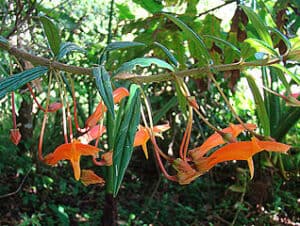
Goldfish plant is an orange flowered houseplant that has leaves green and tiny 1 inch flowers. In tropical areas the plant can climb to the trees and the flower looks like a goldfish from a distance. The scientific name of this plant is Nematanthus ‘Black Gold’ & it is native to Costa Rica, southern Mexico and brazil.
Propagation of goldfish plants is done using stem cuttings & after propagation, you should pour water to make it moist so it again grows roots. Do not overwater as they cannot tolerate root rot issue. The plant can reach a height of 7 to 8 inches and it can spread to almost 17 to 18 inches wider. It can grow in partial shade but still it enjoys warm climate more than cold temperature. The plant has a hardiness zone 10b as they can easily tolerate warm conditions.
Parrot’s Beak
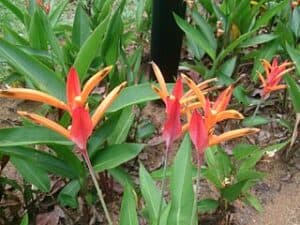
Parrot’s beak is one of the house plants with flowers and its leaves are needle-like, evergreen and beautiful. The scientific name of parrot’s beak is Heliconia psittacorum and they are native to canary and cape verde islands. The plant likes to grow in warm climates and its soil should be fertile to produce flowers. It requires full sun but can adjust to partial shade locations. They do not like too much water intake will leads to root rot. It do requires regular watering because of the higher transpiration rate. You can always check the soil for watering and if its topsoil is dry then make sure to pour water to the fullest.
parrot’s beak can reach to a height of 3 to 5 feet tall and they have usda hardiness zone of 10a. For propagation, you need a good knowledge to divide, take cuttings to make the new plant from the existing one.
Kaffir Lily
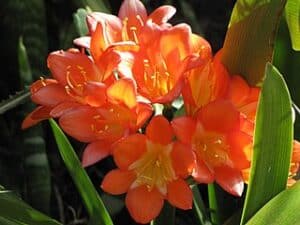
Kaffir lily(Clivia miniata) is an indoor plant with orange flowers that bloom in the spring season. The care is simple and easy for kaffir lilies and it makes the garden more charming and attractive. These plants can be grown outdoors in the garden and inside in container pots. Once you grow this plant it takes a few years to actually produce bloom so patience is needed while growing kaffir lilies.
It can support moderate humidity and can grow in well draining fertile soil. You should also give regular water to it so leaves of kaffir lily don’t get wilted or dry. The flowers are round in shape with orange petals.
It needs bright indirect light to grow & a lot of water in summers while in winters they don’t need too much water which may prevent it from growing. Give it water only if the soil is completely dry.
Lycaste Orchid
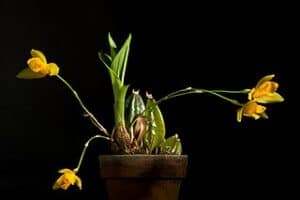
Lycaste Orchid is a variety that has triangular shaped orange flowered houseplants that are large and unique in appearance. Lycaste Orchids belong to South and Central America and they are the most attractive orchids in the world in terms of color. It has over 2 to 3 inch tall flowers that spreads up to 5 to 6 inches with green leaves that are thin. These are usually grown in indirect light and they can tolerate moderate to high humid area. Using a well draining and fertile soil will work for this flowering houseplant. These flowers can bloom in spring and winter months with multiple blooms. Do not give it direct light because they might get sun burn due to high exposure of light.
Ornamental Pepper Plant
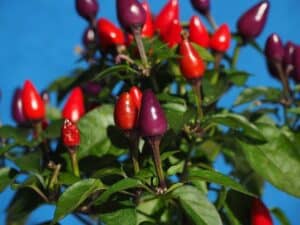
Ornamental pepper plants(Capsicum annum) are house plants with flowers. The plant produces different colored fruits like red, orange, yellow and green but the most popular one was red peppers that is also known by the name christmas pepper. These plants belong to north of south America and south of north America and also caribbean. It is a member of the Solanaceae family and it can reach a height of 15-20 inches tall.
Ornamental pepper plant care includes indirect bright light location and best if you get 2-3 hours of light so it can absorb and fulfill its food requirement. The soil should be nutrient rich for this pepper plant due to its ability to produce fruits. Water should be given thoroughly because that way it can reach the roots of all areas inside the soil.
A mature plant like an ornamental pepper plant can grow up to 3 feet tall while it can spread to 20-24 inches wide.
Bird of Paradise
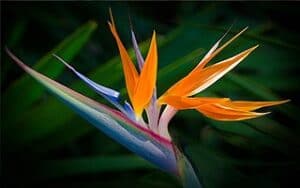
Bird of Paradise(Strelitzia ) is another house plant with orange flowers. Also it is called crane flowers, which have orange as well as white blooms. They are hardy to zone 10 to 12, belonging to Africa . These plants are toxic to pets and they are grown as perennial so it’s easy for them to grow and they require minimal care. You can see the bird of paradise bloom in late winters to early spring.
The height of the bird of paradise is 4 to 6 feet tall and they can spread to 3 to 4 feet wide. You can grow them in partial shade or if you have a garden with full sunlight then you can grow there as these plants can grow in full sun.
It takes over 4 to 5 years for the plant to actually produce any flowers. They need fertilizer in the growing season of spring so use liquid based or slow release plant food to fulfill its requirements. Soil should be a mix of organic compost that will help the plant to grow more. These plants can bloom many times during their blooming year. As the name suggests this plant is used by birds to jump over to the tree or just climb and sit there to rest.
Barberton Daisy
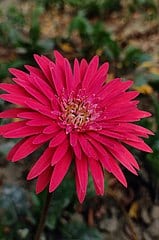
Barberton daisy(Gerbera jamesonii) is a plant belongs to Asteraceae family. they are non toxic to dogs, cats and have a height of 24 inches. They can adjust to temperature between 60 to 75 degrees F and it needs a liquid fertilizer in the growing season every 2-3 weeks so it can bloom orange flowers. These plants can support moderate humidity and need a soil which is peat based & fertile so the plant can grow better and bloom perfectly. Propagation is easy as you need some root cuttings or more simple would be directly sowing seeds that may take many years to plant to bloom. but that can be beneficial for learning purpose of many of the beginner gardeners. Water it often whenever the plant feels dry. Light should be direct or if you have a south facing window then it can receive sufficient light over there.
Potted plants with orange flowers
Potted plants with orange flowers are Basket Vine, Kaffir lily, Christmas Cactus, Barberton daisy, Eternal Flame, Oxalis, Florist Kalanchoe, peace lily, begonias, Golden Brush, flapjack, Goldfish Plant, african voilet, Hippeastrum and so many more. These potted plants has orange flowers that looks beautiful in any interior desk or outside arrangement.
House plants with small orange flowers
Houseplant with small orange flowers are Impatiens walleriana, Fred Ives, Flapjack, begonias, Golden Brush, Prince of Orange, Clivia Miniata, Basket Vine, Kaffir lily, Hippeastrum, Lewisia, barberton daisy, crossandra and so on. The small orange flowers may increase the attractiveness of your house.
What to plant with orange flowers
List of best plants that can be paired with orange flowers includes Pink Polka Dot Plant, Croton, Rex Begonia, African Violet, Calathea, Coleus, Red Aglaonema, Bromeliads, Hedgehog Cactus, Iron Cross Houseplant, Rubber Plant, Persian Shield, Crown of Thorns, Polka Dot Begonia, Coleus, purple heart plant, Chinese Evergreen and so on. The list is long because orange flowers can match with most of the indoor plants perfectly. mainly they can look best with the green leafy plants.
What color flowers go with orange flowers
There are different colors that go with orange flower like any green foliage plant such as Calathea, Peperomia and African Mask. Also Purple, white, blue color flowers can also look good on them. here are some of the plants with various color flowers includes Bromeliads, Iron Cross Houseplant, Pink Polka Dot Plant, Croton, African Violet, Hedgehog Cactus, Calathea, Coleus, Red Aglaonema, , Rubber Plant, Persian Shield, Crown of Thorns, Polka Dot Begonia, Coleus, Chinese Evergreen, Rex Begonia.
What Does Orange flowers Symbolize
Orange flowers symbolize joy, energy, passion, enthusiasm, happiness, warmth and fun due to its different color in autumn. The most common orange flowers are marigolds, tulips, Kaffir Lily, Philodendron ‘Prince of Orange’, Eternal Flame, Arrowhead Plant, Orange Star Plant.
People Also Ask
What are the different types of orange flowers?
here are the different types of orange flowers : Kaffir Lily, Crossandra, Impatiens, Lewisia, Golden Oxalis, Orange Arrowhead Plant, Fred Ives, Flapjack, Flowering Maple, The Orange Star, Barberton Daisy, Rustic Orange, Jelly Bean, Prince of Orange, Clivia Miniata, Bird Of Paradise, Christmas Cactus and so on. They orange blooms looks amazing as a bouquet or in the floral arrangements.
What is an orange flowered weed?
Orange hawkweed, also known as hieracium aurantiacum or devil’s paintbrush, is a lovely perennial plant with vivid orange dandelions-like blooms. Both plants produce seeds, yet they are quite different. Orange hawkweed grows 10-24 inches tall with shallow fibrous roots.
This plant, native to Europe, spreads swiftly and produces a milky sap. The orange hawkweed’s gorgeous blossoms are still praised. This plant can beautify any garden with appropriate care.
Do houseplants have orange flowers?
List of houseplants that grow Indoor with orange flowers includes Impatiens walleriana, Euphorbia pulcherrima ‘Orange Spice’ , Philodendron ‘Prince of Orange’ , Orange Ixora, Golden Oxalis, Orange Lipstick, Orange Star Plant, Eternal Flame and much more. Indoor plants are easy to care and they require less watering and light compared to the outdoor plants.
What is the name of the plant that has orange flowers?
Orange marigold flower is one name that has orange blooms, quite beautiful with 6cm in diameter. They are hardy to zone 8 to 11 and grow in bright light. They belong to the Asteraceae family and they are termed as both annual growing houseplant and perennial growing plants.
What kind of bushes have orange flowers?
Rhododendron ‘Golden Oriole’ are orange bushes that can grow in low maintenance. These flowers are hardy to zone 6 to 8 and can reach to a height of over 10 feet. The soil should have a pH of 4.5 to 5.5 to perfectly grow and they can bloom in early spring months. They like full sun and that is why they need regular watering to support bushes. They have short term flowering that is why it can keep up with low nutrients.”
What shrub has orange flowers in spring?
Golden Oriole azalea, Berberis darwinii, Marigold, California poppies are some of the shrubs that bloom in spring.
Wrap Up
I hope you get the answer on “House plants with Orange Flowers” and if you like to read more such articles check below.
26 Flowers that Start with H – Perennial List of Plants(Pictures)
26 Flowers That Start With U – Perennial Plants(Including Pictures)
22 Flowers That Start With E – Beautiful, Perennials(With Pictures)
32 Flowers That Start With F – Plant Names List(With Pictures)
30 Flowers That Start With G – Plant Names List(With Pictures)
